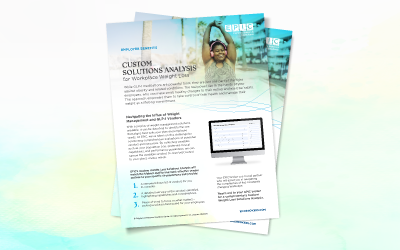Choosing, negotiating a contract, and navigating a relationship with a pharmacy benefit manager (PBM) isn’t one size fits all.
No single PBM is “best” across the board, and customer needs and priorities vary based on many factors – organization type, plan size, member demographics, etc. Our Pharmacy Solutions team at Pharmaceutical Strategies Group (PSG) highlights the intricacy of plan sponsors’ relationships with their PBMs in their latest market research, the 2022 Pharmacy Benefit Manager Customer Satisfaction Report. It outlines high-level satisfaction ratings and dives even deeper into ratings for over 30 services and functions, a dozen clinical and cost management programs, and several special topics (e.g., PBM involvement in addressing social determinants of health, biosimilars strategy, and gene therapy affordability). Let our team take you through the findings in our live webinar on Wednesday, November 9, 2022!
We know it’s tempting to focus on high-level report metrics like overall satisfaction and net promoter score (NPS), which vary across PBMs and are lower in 2022 compared to 2021. This information is valuable, but stopping here misses a more nuanced story that can provide insights to plan sponsors, the consultants and brokers who work with them, and PBMs alike. Keep reading for additional key areas to consider and download the report.
Service and Function Satisfaction
Satisfaction varies widely across the PBM services and functions included in the survey. For example, while plan sponsors – which include health plans, employers, labor unions, and health systems – express high satisfaction with the item retail network options that meet the needs of members (4.5/5, 83% somewhat or very satisfied), they are notably less satisfied with their PBM’s willingness to integrate with other pharmacy solutions (3.7/5, 52% somewhat or very satisfied). It’s also interesting to note areas where plan sponsors show some ambivalence – e.g., 27% of plan sponsors are neither satisfied nor dissatisfied with their PBM’s delivery of products that are differentiated in the marketplace.
Data on service and function satisfaction can help pinpoint areas of particular focus for an organization and benchmark based on overall findings or even evaluate individual PBMs. Each PBM has its own strengths and weaknesses. Focusing on the specific services and functions your organization values most can help with PBM selection and ongoing relationship management. For PBMs, the data highlights areas for improvement and allows for benchmarking versus competitors and the market overall.
Awareness of and Satisfaction with Clinical and Cost Management Programs
Clinical and cost management programs are offered in various forms by most PBMs. Recognizing the importance of these programs in a plan sponsor’s experience with their PBM, the survey asked about their awareness of, use of, and satisfaction with a dozen programs their PBM might offer. Although every PBM does not offer every program on the list, our results suggest that some plan sponsors may be unaware of some of the programs available to them. For plan sponsors, this presents a reminder to keep up to date with their PBM’s offerings, and for PBMs it points to programs about which they might want to provide additional messaging to customers.
The use of clinical and cost management programs varies widely by the program as does satisfaction with the programs used. For example, 90% of plan sponsors who use pharmacy trend guarantees are somewhat or very satisfied overall with them, versus just 66% for medical benefit management programs. These data may indicate to plan sponsors some programs to consider using. They also shed light on which programs are performing well and which programs are producing below-average satisfaction in the industry.
Differences by Segment
Organizations vary in their needs, priorities, and expectations for their PBM, and this leads to variations in customer satisfaction. Factors about the PBM and the customer’s length of relationship with that PBM also produce differences in satisfaction. We evaluated differences in satisfaction across three breakouts: plan sponsor type, size of PBM, and length of relationship with the PBM. The most striking differences appeared in our comparisons of employer and health plan satisfaction with their PBM. On nearly every item, the difference was statistically significant, with lower satisfaction among health plans.
For plan sponsors, these breakouts can provide more context and tailored data for benchmarking purposes. For PBMs, the breakouts indicate customer segments at risk for dissatisfaction and potential non-renewal.
No PBM is perfect – each has its strengths and weaknesses. Furthermore, each benefits plan has a unique set of needs and preferences. Benefits leaders evaluating PBMs should account for the attributes that matter most to their group and seek to find the best-aligned match.
About the 2022 Pharmacy Benefit Manager Customer Satisfaction Report (CSR)
This annual report summarizes overall satisfaction with pharmacy benefit managers and satisfaction with over 40 PBM functions and services beyond overall satisfaction. The most comprehensive research of its type for the PBM space, it is widely recognized for the comparative information it provides to benefit executives responsible for researching, selecting, and managing PBMs. Survey participants included health plans, employers, health systems, and labor unions who seek detailed intelligence to enhance their ability to strategically manage pharmacy benefits. View more of our Pharmacy Solutions research on PSG’s website.
Pharmaceutical Strategies Group (PSG) joined EPIC in 2021, bringing the knowledge and resources of one of the nation’s largest independent pharmacy benefit consulting firms into the EPIC Employee Benefits Consulting practice.
ATTEND THE REPORT WEBINAR
on Wednesday, November 9
Dive Deeper into the 2022 PBM Customer Satisfaction Report Findings
Related Content
Products
Employee Benefits Consulting
Our dedicated benefits team is focused on delivering better outcomes – to both your benefits program and ...
Products
Pharmacy Solutions
Our Pharmacy Consulting Practice helps companies navigate the unique complexities of expertly managing the ...
Insights
EPIC Insurance Brokers & Consultants Acquires Pharmaceutical Strategies Group
EPIC announced today that it has agreed to acquire Pharmaceutical Strategies Group (PSG). The move ...


